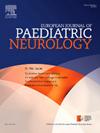Genotype variability in early-onset Hereditary Spastic Paraplegia: a single-center study
IF 2.3
3区 医学
Q3 CLINICAL NEUROLOGY
引用次数: 0
Abstract
Hereditary spastic paraplegias (HSPs) are genetically and clinically heterogeneous, slowly progressive neurological disorders characterized by primary involvement of the corticospinal tracts. The early-onset forms of HSP (EO-HSP) are often defined as “cerebral palsy mimics” since symptoms begin in infancy and manifest as spastic di- or tetraplegia and possible neurodevelopmental disorder. The rarity and heterogeneity of these disorders make their diagnosis challenging.
In this single-center study, we focus on the outcomes and diagnostic detection rate of EO-HSP patients from a cohort of 104 consecutive HSP cases.
The discussion highlights the genetic variability in cases of EO-HSP that tested positive through a series of molecular analyses, particularly those requiring further investigation via whole exome sequencing (WES). This approach has shed light on the etiopathogenetic role of 19 variants across 10 different genes (COQ4, FOXG1, GRIN2B, HPDL, LRP2, RBMX, SPART, TBCD, ZBTB11, and ZC4H2) in 14 patients with complex EO-HSP. Notably, most of these genes are not conventionally classified as HSP-related or included in the SPG classification on the Online Mendelian Inherited in Men (OMIM) catalog.
We emphasize the importance of detailed genotype-phenotype correlations and the diagnostic potential of a highly specialized translational approach in clinically selected cases lacking molecular confirmation, thereby expanding our understanding of the genetic variability of EO-HSP.
早发遗传性痉挛性截瘫的基因型变异:一项单中心研究
遗传性痉挛性截瘫(HSPs)是一种遗传和临床异质性的缓慢进行性神经系统疾病,其特征是主要累及皮质脊髓束。早发型HSP (EO-HSP)通常被定义为“脑瘫模拟”,因为症状始于婴儿期,表现为痉挛性四肢瘫痪和可能的神经发育障碍。这些疾病的罕见性和异质性使其诊断具有挑战性。在这项单中心研究中,我们重点研究了104例连续HSP病例中EO-HSP患者的预后和诊断检出率。讨论强调了通过一系列分子分析检测阳性的EO-HSP病例的遗传变异性,特别是那些需要通过全外显子组测序(WES)进一步调查的病例。该方法阐明了14例复杂EO-HSP患者中10个不同基因(COQ4、FOXG1、GRIN2B、HPDL、LRP2、RBMX、SPART、TBCD、ZBTB11和ZC4H2)的19个变异的发病作用。值得注意的是,这些基因中的大多数没有被传统地归类为与热敏感蛋白相关的基因,也没有被包括在男性在线孟德尔遗传(OMIM)目录中的SPG分类中。我们强调详细的基因型-表型相关性的重要性,以及在缺乏分子证实的临床选择病例中高度专业化的翻译方法的诊断潜力,从而扩大了我们对EO-HSP遗传变异性的理解。
本文章由计算机程序翻译,如有差异,请以英文原文为准。
求助全文
约1分钟内获得全文
求助全文
来源期刊
CiteScore
6.30
自引率
3.20%
发文量
115
审稿时长
81 days
期刊介绍:
The European Journal of Paediatric Neurology is the Official Journal of the European Paediatric Neurology Society, successor to the long-established European Federation of Child Neurology Societies.
Under the guidance of a prestigious International editorial board, this multi-disciplinary journal publishes exciting clinical and experimental research in this rapidly expanding field. High quality papers written by leading experts encompass all the major diseases including epilepsy, movement disorders, neuromuscular disorders, neurodegenerative disorders and intellectual disability.
Other exciting highlights include articles on brain imaging and neonatal neurology, and the publication of regularly updated tables relating to the main groups of disorders.

 求助内容:
求助内容: 应助结果提醒方式:
应助结果提醒方式:


